I am writing a little code in J2ME. I have a class with a method setTableId(Short tableId). Now when I try to write setTableId(100) it gives compile time error. How can I set the short value without declaring another short variable?
When setting Long value I can use setLongValue(100L) and it works. So, what does L mean here and what's the character for Short value?
Thanks


